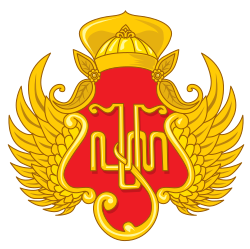Special Region of Yogyakarta
The Special Region of Yogyakarta (Indonesian: [Daerah Istimewa (D.I.) Yogyakarta] Error: {{Lang}}: text has italic markup (help), pronounced /ˌjɒɡjəˈkɑːrtə/; Javanese: ꦣꦲꦺꦫꦃꦲꦶꦯ꧀ꦡꦶꦩꦺꦮꦔꦪꦺꦴꦒꦾꦏꦂꦠ Dhaérah Istiméwa Yogyakarta) is a provincial-level autonomous region of Indonesia in the south of Java.[5] Indian Ocean is on the southern side of the Special Region. The Special Region is located next to Central Java. Yogyakarta is ruled by the Yogyakarta Sultanate, the only official monarchy in the government of Indonesia. The city of Yogyakarta is a popular tourist destination and cultural center of the region.
Flag Seal | |
|
| |
 Location of the Special Region of Yogyakarta in Indonesia | |
| Coordinates: 7°47′S 110°22′E / 7.783°S 110.367°ECoordinates: 7°47′S 110°22′E / 7.783°S 110.367°E | |
| Established | 4 March 1950 |
| Capital and largest city | Yogyakarta |
| Government | |
| • Type | Devolved Sultan-led special region |
| • Body | Yogyakarta Special Region Government |
| • Governor (Sultan) | Hamengkubuwana X |
| • Vice Governor (Paku Alam) | Paku Alam X |
| Area | |
| • Total | 3,133.15 km2 (1,209.72 sq mi) |
| • Rank | 33rd in Indonesia |
| Highest elevation | 2,955 m (9,695 ft) |
| Population (2020 census)[1] | |
| • Total | 3,668,719 |
| • Rank | 18th in Indonesia |
| • Density | 1,170.9363/km2 (3,032.711/sq mi) |
| Demographics | |
| • Ethnic groups | 96% Javanese 0.6% Sundanese 3.4% other[2] |
| • Religion | 92.94% Islam 4.11% Catholicism 2.44% Protestantism 0.43% Hinduism 0.09% Buddhism 0.002% others[3] |
| • Languages | Indonesian (official) Javanese (official regional) |
| Time zone | UTC+7 (WIB) |
| ISO 3166 code | ID-YO |
| HDI | |
| HDI rank | 2nd (2020) |
| Website | jogjaprov |
The Yogyakarta Sultanate was established in 1755 and supported for Indonesia's independence during the Indonesian National Revolution (1945–1949). Yogyakarta is led by Sultan Hamengkubuwono X as the governor and Prince Paku Alam as the vice governor. The Special Region has a land area of 3,185.8km2. It is the second-smallest province of Indonesia after Jakarta.[6]
Government and politics
Governor
Special Region is led by a governor who is helped by a vice governor. The governor and vice governor of the Special Region are chosen by the President. The governor must be a Sultan of Yogyakarta and the vice governor must be a Price of Pakualaman[7]
Administrative divisions
The Special Region of Yogyakarta is subdivided into four regencies (kabupaten) and one city (kota):
| Name | Capital | Area (km2) | Population 2000 Census |
Population 2010 Census |
Population 2020 Census |
HDI[8] 2018 Estimates |
|---|---|---|---|---|---|---|
| Yogyakarta City | Yogyakarta City | 32.50 | 396,700 | 388,627 | 373,589 | 0.861 (Very High) |
| Bantul Regency | Bantul | 508.13 | 781,000 | 911,503 | 985,770 | 0.794 (High) |
| Gunung Kidul Regency | Wonosari | 1,431.42 | 670,400 | 675,382 | 747,161 | 0.692 (Medium) |
| Kulon Progo Regency | Wates | 586.28 | 371,000 | 388,859 | 436,395 | 0.737 (High) |
| Sleman Regency | Sleman | 574.82 | 901,400 | 1,093,110 | 1,125,804 | 0.834 (Very High) |
| Totals | 3,133.15 | 3,121,045 | 3,457,491 | 3,668,719 | 0.795 (High) |
The city of Yogyakarta is located in the Special Region of Yogyakarta. It is a hub of classical Javanese fine art and culture such as batik, ballet, drama, music, poetry, and puppet shows. It is also one of Indonesia's centers of higher education. At the city's center is the Sultan's palace called the Kraton. The city spread in all directions from the Kraton, the modern city core is in the north.
Demographics
| Historical population | ||
|---|---|---|
| Year | Population | ±% |
| 1971 | 2,489,360 | — |
| 1980 | 2,750,813 | +10.5% |
| 1990 | 2,913,054 | +5.9% |
| 1995 | 2,916,779 | +0.1% |
| 2000 | 3,122,268 | +7.0% |
| 2010 | 3,457,491 | +10.7% |
| 2020 | 3,668,719 | +6.1% |
| Source: Badan Pusat Statistik (BPS), 2021 | ||
Religion
The majority of the population is Muslim, which is 92.94%, followed by Catholic Christians 4.11%, then Protestant Christians 2.44%, Hindus 0.43%, Buddhists 0.09% and Confucianism 0.02%.[9]
Sister relationship
Yogyakarta Special Region has signed sister province relationship with region/state:
 Kyoto Prefecture, Japan[10][11]
Kyoto Prefecture, Japan[10][11] Victoria, Australia[11]
Victoria, Australia[11] Gyeongsangbuk-do, South Korea[12][11]
Gyeongsangbuk-do, South Korea[12][11] Yamanashi Prefecture, Japan[11]
Yamanashi Prefecture, Japan[11]
Special Region Of Yogyakarta Media
Praja Cihna (Javanese: ꦥꦿꦗꦕꦶꦃꦤ), coat of arms or crest of the Yogyakarta Sultanate that is upheld by Mataram society. The crest contains the Javanese script ꦲꦨ꧀ꦮ, a royal monogram of Hamengkubuwono.
The Special Region of Yogyakarta's parliament (DPRD) building
References
- ↑ "Census Result 2020". yogyakarta.bps.go.id.
- ↑ Indonesia's Population: Ethnicity and Religion in a Changing Political Landscape. Institute of Southeast Asian Studies. 2003.
- ↑ "Provinsi DI Yogyakarta Dalam Angka 2021". www.bps.go.id. Retrieved 2021-11-08.
- ↑ "Metode Baru Indeks Pembangunan Manusia 2019-2020". www.bps.go.id. Retrieved 2021-11-08.
- ↑ "Nomenklatur Daerah Istimewa Yogyakarta dan Penggunaannya" (PDF).
- ↑ "Luas wilayah". jogjaprov.go.id. 1 June 2010. Archived from the original on 2020-10-01. Retrieved 2021-11-07.
- ↑ "Undang-undang Nomor 13 Tahun 2012 tentang Keistimewaan Daerah Istimewa Yogyakarta". LawNo. 13of2012 (in Bahasa Indonesia). People's Representative Council.
- ↑ "Pembangunan Manusia | Provinsi D I Yogyakarta". ipm.bps.go.id. Archived from the original on 2021-04-26. Retrieved 2021-11-08.
- ↑ "Daerah DIY - Jumlah Pemeluk Agama". bappeda.jogjaprov.go.id. Archived from the original on 2020-02-25. Retrieved 2021-09-14.
- ↑ "Kyoto prefecture List of Friendly and Sister City". pref.kyoto.jp. Retrieved 2021-11-08.
- ↑ 11.0 11.1 11.2 11.3 "Kerjasama Luar Negeri DI Yogyakarta". jogjaprov.go.id. Archived from the original on 2021-11-08. Retrieved 2021-11-08.
- ↑ "Gyeongsangbuk-do Province Website". Retrieved 2021-11-08.






